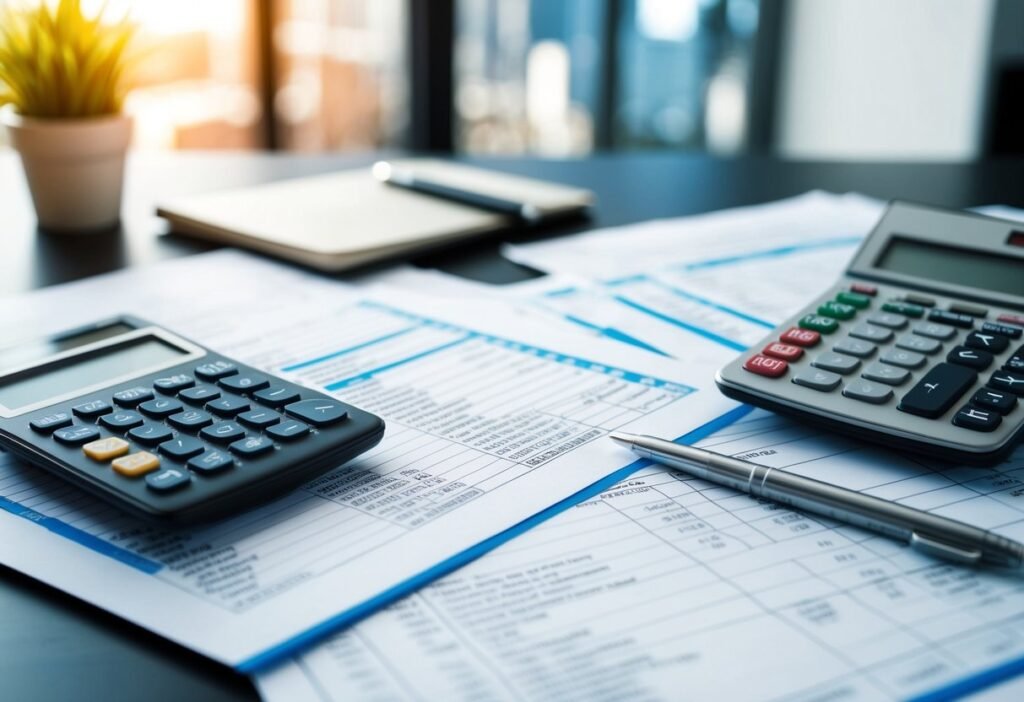Understanding cash flow is essential for making smart decisions about rental properties, especially if you use strategies like BRRRR. Cash flow is the money left after subtracting all expenses from your rental income, giving you a clear picture of your property’s financial performance. Knowing how to accurately calculate and track cash flow helps you find profitable investments and avoid costly surprises.
This step-by-step guide will show you exactly how to project and monitor the cash flow for your rental properties using proven real estate metrics and analysis methods. You’ll find straightforward answers to common questions and learn what numbers really matter for your success as an investor.
Key Takeaways
- Learn the basics of cash flow and how it impacts your investments
- Understand which income and expenses to include in your calculation
- Explore reliable methods to analyze cash flow and support your decisions
Key Components of Cash Flow in Rental Properties
Accurately projecting and tracking cash flow for your rental properties requires careful attention to income, expenses, and periodic fluctuations like vacancies. Understanding these elements will help you make smarter decisions and assess your BRRRR investments with greater confidence.
Understanding Rental Income
Rental income forms the foundation of cash flow analysis. Your gross rental income includes the total rent collected from tenants each month. Additional revenue streams, such as pet fees, parking charges, or laundry services, should also be considered.
Consistently track all sources of income to ensure your calculations reflect actual earnings. Market rents and lease agreements impact your expected income, so stay informed about local trends to set competitive rates.
It’s essential to differentiate between gross and net rental income. Gross is the full amount before expenses, while net deducts costs like vacancies or concessions offered to tenants.
Operating Expenses and Their Impact
Operating expenses can significantly affect your monthly cash flow. Typical operating expenses for rental properties include property taxes, insurance premiums, maintenance, repairs, and property management fees.
These costs are often recurring but can also arise unexpectedly, such as emergency repairs. Tracking both fixed and variable expenses is crucial for accurate projections. For example, certain costs like property management are predictable, while maintenance needs may fluctuate.
Create a detailed list of monthly expenses to avoid overlooking items. Common expense categories include:
- Property taxes
- Insurance premiums
- Repairs and maintenance
- Utilities (if paid by landlord)
- HOA fees
- Property management
Accurately subtracting these from your rental income provides a clear view of true cash flow.
Net Operating Income and Cash Flow Calculation
Net operating income (NOI) is a crucial metric in real estate cash flow analysis. You arrive at NOI by subtracting operating expenses from gross rental income.
NOI = Gross Rental Income – Operating Expenses
This figure represents the income generated by your rental property before accounting for debt service, capital expenditures, or taxes. Cash flow, however, is the amount left over after subtracting loan payments from NOI.
Use NOI as a starting point to evaluate the profitability of a property. When reviewing prospective BRRRR investments, ensure expected NOI covers not just debt, but also leaves a margin for unexpected costs.
A detailed breakdown of cash flow calculation steps can streamline your analysis.
Assessing Vacancy and Its Effects
Vacancy directly reduces your rental income and, by extension, cash flow. Vacancy rates represent the percentage of time a rental unit remains unoccupied during the year.
It’s important to estimate a realistic vacancy rate based on your property type and location. Higher vacancy rates mean lost income and impact your ability to cover monthly expenses. If you have frequent turnovers, factor in potential costs like cleaning and repairs between tenants.
Include an allowance for vacancy in your financial projections. Many investors use a standard rate—often 5%—to account for typical downtime. Failing to plan for vacancies can lead to cash shortfalls, especially when fixed costs still need to be paid.
Effectively managing tenant retention and responding to market demand can help minimize vacancy and its negative effects on your rental property’s performance. For more on how vacancy is factored into cash flow, see this cash flow analysis guide from DoorLoop.
Cash Flow Analysis Methods and Real Estate Investment Metrics
Precise cash flow analysis is the foundation for selecting, operating, and scaling investment properties. Understanding the metrics and methods discussed in this section will help you make informed decisions and benchmark the performance of each property in your portfolio.
Calculating Net Cash Flow and Annual Cash Flow
Net cash flow is the difference between your property’s total rental income and all operating expenses for a set period. Include expenses such as mortgage payments, insurance, taxes, maintenance, utilities, property management fees, and vacancy loss. For the BRRRR strategy, also account for financing costs, like interest on short-term loans used during the rehabilitation phase.
To find annual cash flow, multiply your monthly net cash flow by 12. This result gives you a clear overview of your property’s yearly profitability. Calculating net and annual cash flow can be summarized as:
Net Cash Flow = Total Income – Total Expenses
Annual Cash Flow = Net Cash Flow x 12
Tools such as an APOD sheet or cash flow worksheet can help you track these figures consistently.
Understanding Return on Investment (ROI) and Cap Rate
Return on investment (ROI) is calculated by dividing your annual returns by your total investment, factoring in your down payment, closing costs, and any funds spent on renovations. For accurate ROI measurement, include gains from both annual cash flow and potential appreciation of the investment property. Knowing your ROI helps you compare different property types and markets for the best opportunities.
Cap rate, or capitalization rate, measures an asset’s expected return without considering financing. It is calculated as Annual Net Operating Income ÷ Purchase Price. A higher cap rate may indicate a riskier property or less desirable location, while a lower cap rate usually means steadier returns in a stable market. These metrics play a crucial role in property cash flow analysis.
Cash-on-Cash Return Explained
Cash-on-cash return shows the actual return on the cash you’ve invested, not the total property value. Calculate it as Annual Pre-Tax Cash Flow ÷ Total Cash Invested. For BRRRR investments, count your full out-of-pocket costs—such as down payments, closing costs, and major repairs—before refinancing.
Unlike ROI, cash-on-cash return isolates how efficiently your invested dollars are generating income each year. This metric is especially helpful for comparing properties with different financing structures or levels of leverage. Reviewing cash flow and ROI calculations helps ensure your investment aligns with your risk tolerance and long-term goals.
Frequently Asked Questions
When managing rental properties, it’s important to use standardized formulas and reliable tools to analyze your projected and actual income. Understanding how to set up calculations and choose the right methods helps ensure accurate cash flow management for your BRRRR investments.
How can I create a cash flow spreadsheet for my rental property?
Start by listing your total monthly rental income and itemizing all property expenses, such as mortgage payments, property taxes, insurance, repairs, and vacancy losses. Subtract the total expenses from your gross income to see your monthly net cash flow.
You can use spreadsheet software like Excel or Google Sheets for easy calculations and adjustments as your income and expenses change over time.
What is an example of a cash flow calculation for a rental property?
Suppose your monthly rent is $2,000. Your monthly expenses include a $1,200 mortgage, $150 for insurance, $100 in property taxes, and $100 in maintenance. The total expenses add up to $1,550.
Your cash flow would be $2,000 minus $1,550, leaving you with $450 in positive cash flow each month. For more details, visit this walkthrough of cash flow analysis.
Where can I find a rental property calculator for Excel?
Several online platforms offer free and downloadable Excel templates tailored for rental property analysis. These calculators allow you to input your income and expense data and automatically compute cash flow and ROI.
You may want to check out the ready-to-use cash flow rental property calculator available online, which can simplify data entry and automate calculations.
How do I use a rent calculator to determine the appropriate charge for my tenants?
Enter details such as property address, market rent data, amenities, and lease terms into a rent calculator. Adjust variables for local competition and costs to find a fair and competitive rent amount.
These tools help you make data-informed decisions without undervaluing or overpricing your rental units.
What formula should I utilize for calculating real estate cash flow?
The basic formula for calculating cash flow is:
Net Operating Income (NOI) – Mortgage Payment = Cash Flow
NOI includes rental income minus operating expenses, not including mortgage principal and interest. The result tells you the actual profit after accounting for debt service, as highlighted in this guide on cash flow calculation.
How do I calculate the return on investment (ROI) for my rental property?
Take your annual cash flow (monthly cash flow multiplied by 12) and divide it by your total cash invested in the property, including down payment and closing costs.
Multiply by 100 to express ROI as a percentage. This calculation helps you compare different investment properties and track the performance of your BRRRR investments.
Wondering if you’re charging enough rent? Here’s how to know for sure….
Make data-driven rental property decisions with real-time market insights from RentCast.io. Use code BIGDEAL for 20% off your subscription!

Discover the secret to stress-free property management with How To Find & Keep Great Tenants. This essential guide reveals proven strategies for attracting high-quality renters and creating long-term, mutually beneficial relationships.
But finding great tenants is only half the battle. Uncover the art of tenant retention, from creating a positive living environment to addressing concerns promptly and professionally.
With this book, you’ll transform your rental property into a sought-after home that tenants won’t want to leave. Minimize vacancies, reduce turnover costs, and maximize your investment’s potential by mastering the skills to find and keep exceptional tenants.
Get your copy now from your favorite bookseller:
- Amazon (non-Premium Edition, does not include Investment Real Estate Analysis: A Case Study, available in paperback only)
- Books2Read for Apple, Barnes & Noble, Kobo, Scribed, and 8 more sellers with both eBook and paperback options available (Premium Edition)
- Payhip as a downloadable PDF (Premium Edition)






